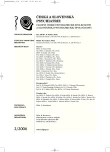Relation between Body Weight-Height and Menstruation in Patients with Anorexia Nervosa
Authors:
H. Krásničanová; M. Veselá
Authors‘ workplace:
Pediatrická klinika 2. LF UK a FN Motol, Praha
přednosta prof. MUDr. J. Vavřinec, DrSc.
Published in:
Čes. a slov. Psychiat., 102, 2006, No. 2, pp. 66-72.
Category:
Original Article
Overview
The article is oriented on specific aspects of therapy of eating disorders (ED) in pubescent and adolescent girls, connected with non finished biological development in time of severe malnutrition. Specifically the issue of: 1. the exact determination of recommended body weight (target weight, weight for dimision etc.) on the basis of the exact analysis of the weight anamnesis, 2. relation between body weight and menstruation (menarche, amenorrhoea a remenorrhoea.) and 3. risk for nonrealization of the growth genetic potential (status of linear growth and skeletal maturity) is discussed. The part of the article represents the results of data analysis of 90 patients with anorexia nervosa and auxological characteristic of pubertal events in the recent European girl. The authors advert to attention the importance of the exact analysis of the growth and weight history and making provision for biological age in girls with eating disorders and their importance for successful and reasonable therapeutical mode of the realimentation.
Key words:
anorexia nervosa in adolescence, biological age, growth diagnosis, puberty, analysis of the weight anamnesis, standard and target weight, realimentation algorithm, body mass index, menarche, amenorrhoea, remenorrhoea.
Labels
Addictology Paediatric psychiatry PsychiatryArticle was published in
Czech and Slovak Psychiatry

2006 Issue 2
Most read in this issue
- Sleep and Attention-Deficit/Hyperactivity Disorder Overview of Present-Day Information
- Relation between Body Weight-Height and Menstruation in Patients with Anorexia Nervosa
- Pharmacological Influence on Glutamatergic System in Schizophrenia
- The Wellness Program - the Glance Back to the First Year
